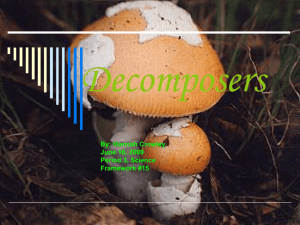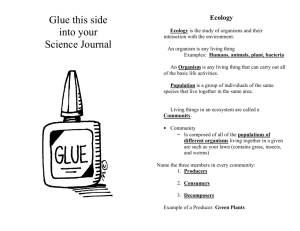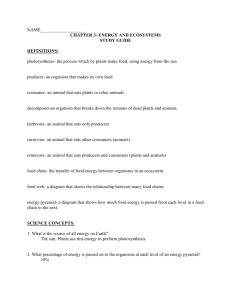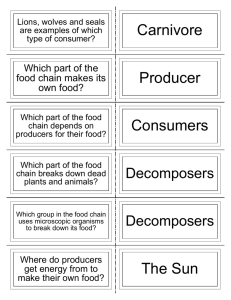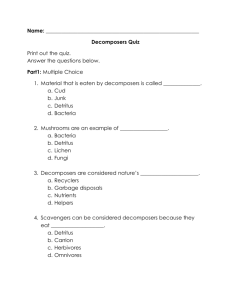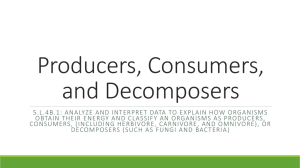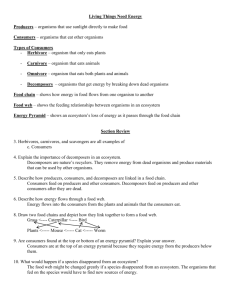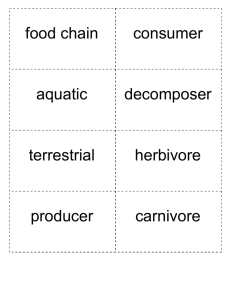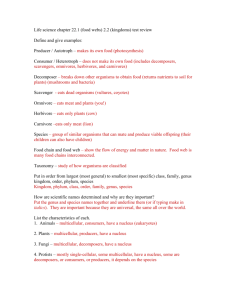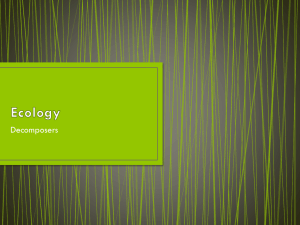REACHING ALL STUDENTS Food Chains Three Kinds of Organisms
advertisement
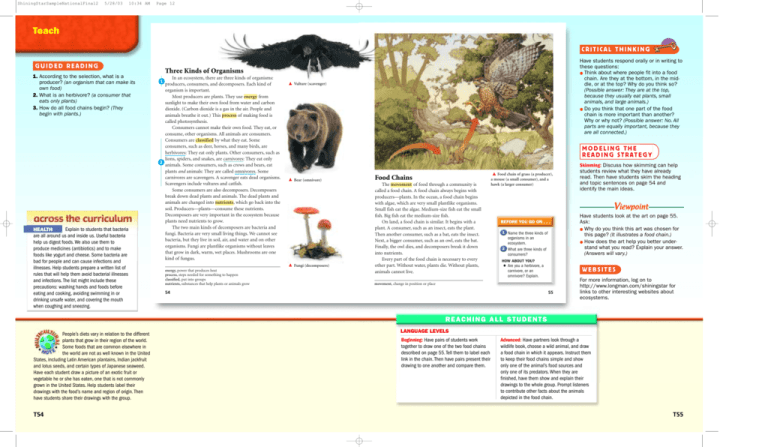
ShiningStarSampleNationalFinal2 5/28/03 10:34 AM Page 12 Teach GUIDED READING ▼ energy, power that produces heat process, steps needed for something to happen classified, put into groups nutrients, substances that help plants or animals grow Vulture (scavenger) MODELING THE R E A D I N G ST R AT E G Y ▼ In an ecosystem, there are three kinds of organisms: producers, consumers, and decomposers. Each kind of organism is important. Most producers are plants. They use energy from sunlight to make their own food from water and carbon dioxide. (Carbon dioxide is a gas in the air. People and animals breathe it out.) This process of making food is called photosynthesis. Consumers cannot make their own food. They eat, or consume, other organisms. All animals are consumers. Consumers are classified by what they eat. Some consumers, such as deer, horses, and many birds, are herbivores: They eat only plants. Other consumers, such as lions, spiders, and snakes, are carnivores: They eat only 2 animals. Some consumers, such as crows and bears, eat plants and animals: They are called omnivores. Some carnivores are scavengers. A scavenger eats dead organisms. Scavengers include vultures and catfish. Some consumers are also decomposers. Decomposers break down dead plants and animals. The dead plants and animals are changed into nutrients, which go back into the soil. Producers—plants—consume these nutrients. Decomposers are very important in the ecosystem because plants need nutrients to grow. The two main kinds of decomposers are bacteria and fungi. Bacteria are very small living things. We cannot see bacteria, but they live in soil, air, and water and on other organisms. Fungi are plantlike organisms without leaves that grow in dark, warm, wet places. Mushrooms are one kind of fungus. 1 Bear (omnivore) Fungi (decomposers) ▼ Explain to students that bacteria HEALTH are all around us and inside us. Useful bacteria help us digest foods. We also use them to produce medicines (antibiotics) and to make foods like yogurt and cheese. Some bacteria are bad for people and can cause infections and illnesses. Help students prepare a written list of rules that will help them avoid bacterial illnesses and infections. The list might include these precautions: washing hands and foods before eating and cooking, avoiding swimming in or drinking unsafe water, and covering the mouth when coughing and sneezing. Three Kinds of Organisms ▼ 1. According to the selection, what is a producer? (an organism that can make its own food) 2. What is an herbivore? (a consumer that eats only plants) 3. How do all food chains begin? (They begin with plants.) Have students respond orally or in writing to these questions: ● Think about where people fit into a food chain. Are they at the bottom, in the middle, or at the top? Why do you think so? (Possible answer: They are at the top, because they usually eat plants, small animals, and large animals.) ● Do you think that one part of the food chain is more important than another? Why or why not? (Possible answer: No. All parts are equally important, because they are all connected.) Food Chains The movement of food through a community is called a food chain. A food chain always begins with producers—plants. In the ocean, a food chain begins with algae, which are very small plantlike organisms. Small fish eat the algae. Medium-size fish eat the small fish. Big fish eat the medium-size fish. On land, a food chain is similar. It begins with a plant. A consumer, such as an insect, eats the plant. Then another consumer, such as a bat, eats the insect. Next, a bigger consumer, such as an owl, eats the bat. Finally, the owl dies, and decomposers break it down into nutrients. Every part of the food chain is necessary to every other part. Without water, plants die. Without plants, animals cannot live. Food chain of grass (a producer), a mouse (a small consumer), and a hawk (a larger consumer) BEFORE YOU GO ON . . . Name the three kinds of organisms in an ecosystem. What are three kinds of consumers? Skimming: Discuss how skimming can help students review what they have already read. Then have students skim the heading and topic sentences on page 54 and identify the main ideas. Have students look at the art on page 55. Ask: ● Why do you think this art was chosen for this page? (It illustrates a food chain.) ● How does the art help you better understand what you read? Explain your answer. (Answers will vary.) HOW ABOUT YOU? ● Are you a herbivore, a carnivore, or an omnivore? Explain. WEBSITES movement, change in position or place 55 54 For more information, log on to http://www.longman.com/shiningstar for links to other interesting websites about ecosystems. REACHING ALL STUDENTS People’s diets vary in relation to the different plants that grow in their region of the world. Some foods that are common elsewhere in the world are not as well known in the United States, including Latin American plantains, Indian jackfruit and lotus seeds, and certain types of Japanese seaweed. Have each student draw a picture of an exotic fruit or vegetable he or she has eaten, one that is not commonly grown in the United States. Help students label their drawings with the food’s name and region of origin. Then have students share their drawings with the group. T54 LANGUAGE LEVELS Beginning: Have pairs of students work together to draw one of the two food chains described on page 55. Tell them to label each link in the chain. Then have pairs present their drawing to one another and compare them. Advanced: Have partners look through a wildlife book, choose a wild animal, and draw a food chain in which it appears. Instruct them to keep their food chains simple and show only one of the animal’s food sources and only one of its predators. When they are finished, have them show and explain their drawings to the whole group. Prompt listeners to contribute other facts about the animals depicted in the food chain. T55
